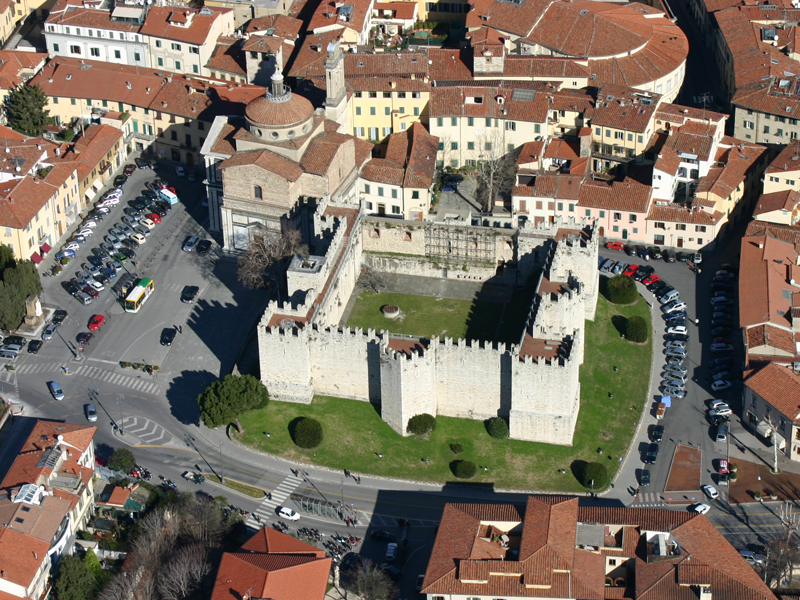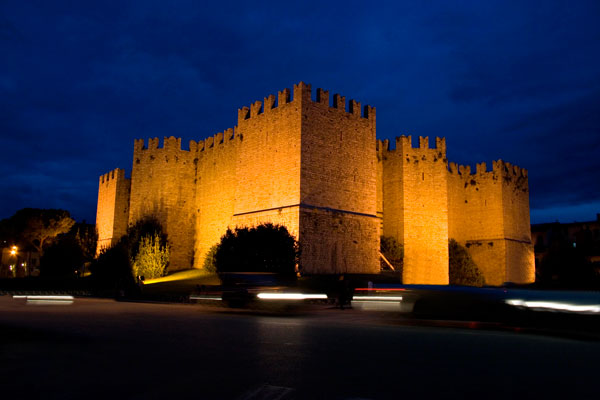
ITA
Il Castello dell'Imperatore, conosciuto anche come Fortezza di S.Barbara o Castello Svevo, può essere considerato la più importante testimonianza architettonica dei secoli XI°-XIII° presente nella città di Prato. La sua particolarità, e anomalità principale, è che in pratica stiamo parlando di uno stupendo esempio di maniero Svevo, l'unico nel centro-nord d'Italia! La sua collocazione geografica perfetta sarebbe stata nell'Italia del Sud accanto a capolavori di architettura fortificata come Castel Del Monte o Lagopesole. La costruzione fu iniziata nel 1248 per volere dell'Imperatore Federico II di Svevia, nell'ambito di un progetto finalizzato a porre sotto controllo militare le principali vie di comunicazioni che dal sud del paese portavano in Germania, in particolare la strada che dal passo di Montepiano portava attraverso la valle de Bisenzio al cuore della Toscana.
Il castello è opera dell'architetto Riccardo da Lentini, 'magister' a capo di maestranze fatte giungere appositamente dalla Puglia, e fu eretto sul terreno che già ospitava una fortificazione minore, donato all'imperatore da una famiglia Ghibellina pratese.
L'edificio ha pianta quadrata, con quattro torri agli angoli e altre quattro, di cui due disposte a sperone e due ereditate dal precedente fortilizio [ed in origine molto più elevate di adesso], al centro di ogni lato della cortina muraria. Il coronamento delle mura e delle torri è realizzato con i caratteristici merli Ghibellini a coda di rondine. Le torri della preesistente fortificazione inglobate nella fortezza hanno pregiudicato il risultato geometrico della pianta, non perfetto come negli altri castelli Svevi dell' Italia meridionale, ma non il simbolismo dell'ottagono [sono comunque otto le torri presenti].
ENG
he Emperor's Castle, also known as Fortress of S.Barbara or Castello Svevo, is considered the most important Prato's testimony of 11-13th centuries architecture. It was the headquarters of the Imperial party in the Florentine countryside, seat of the Imperial Viceroy of Tuscany. The main feature of the castle is its aspect: a marvelous example of Federician Castle like the other masterpieces that we can find in the South of Italy, as Castel del Monte or Lagopesole, the only in this part of the Italian peninsula.
The castle's construction begun in 1237 and ended in 1248 by order of the Holy Roman Emperor Frederick II of Swabia, in the circle of his project to set under military control the principal ways of communications that brought to Germany, in detail the road that, coming down from the Montepiano Pass (the lowest in the Apennines) crossed the Bisenzio Valley in the heart of Tuscany. This strategical location made the castle an important key in the plan for the new organization of the Italian Kingdom pursued by Frederick Hohenstaufen in the years immediately after his victory at Cortenuova (27 November 1237). This system of fortification consisting in other castles, walled villages (like the near Calenzano) and strongholds all in visual contact (with fire or smoke signals) with each other. At the end of Frederick's Imperial dream the chain was consolidated by Florence, at defense of its important trade routes.
The 'Magister Murorum' [architect] of the castle's was Riccardo da Lentini [supervisor of the construction of Emperor's other castles in Puglia] with masonry come on purpose from the south. The site of the fortress already held a small fortress, given to the Emperor from a Ghibelline family of Prato, that was incorporated in the new castle.
